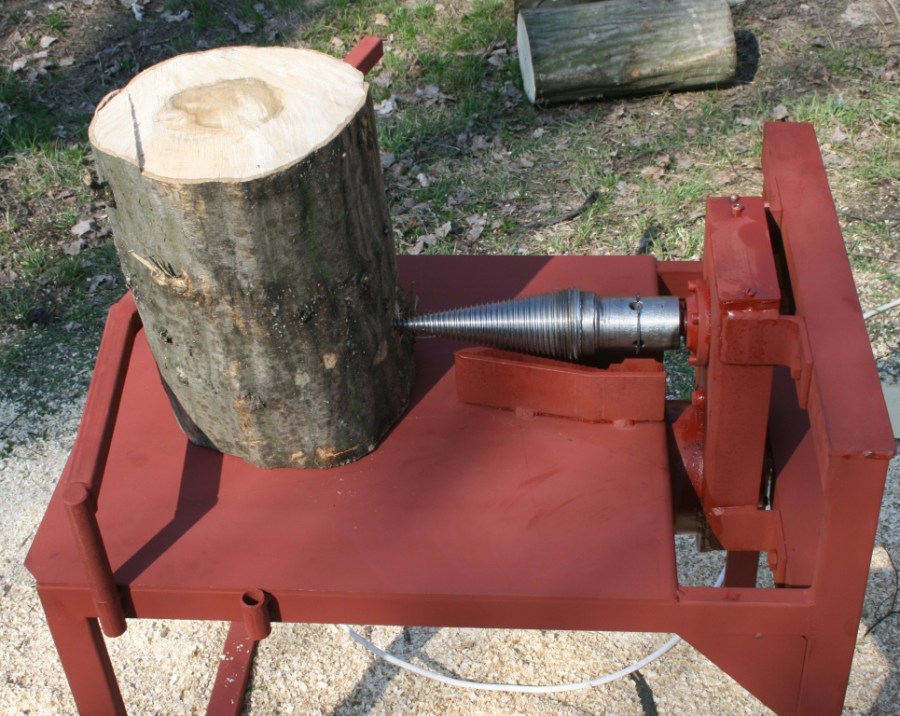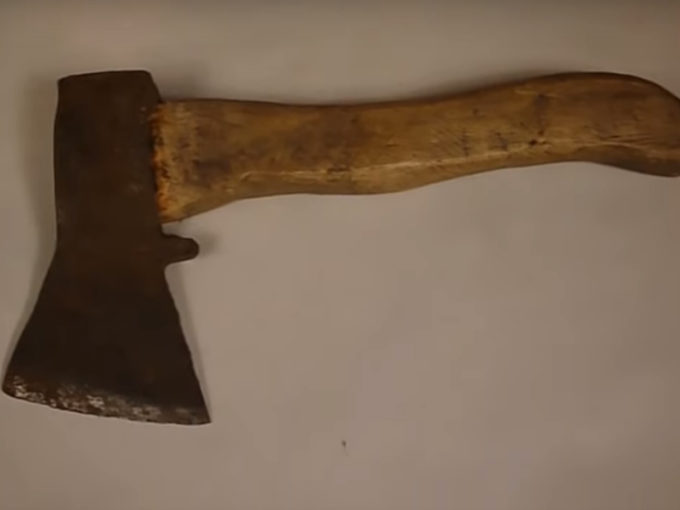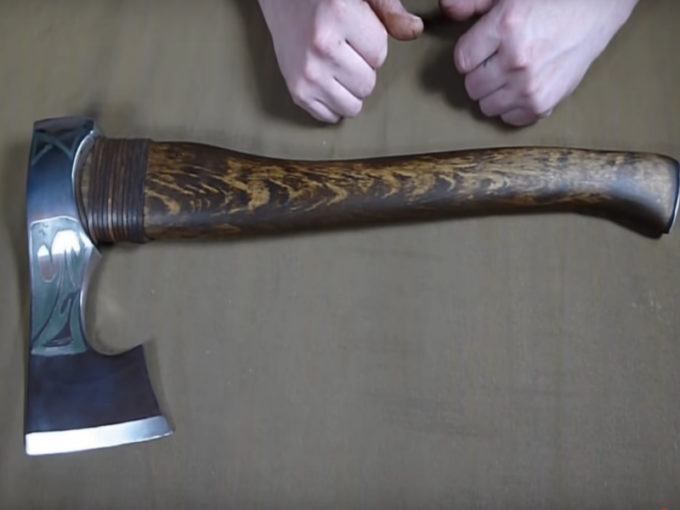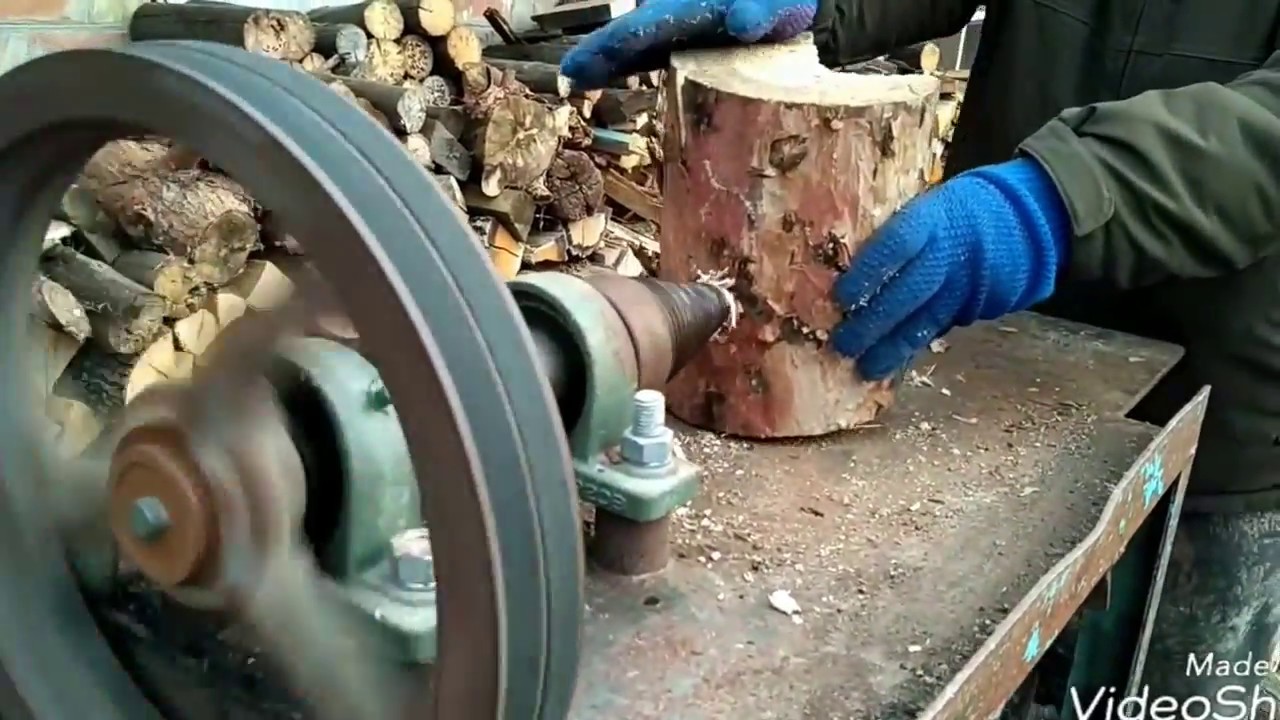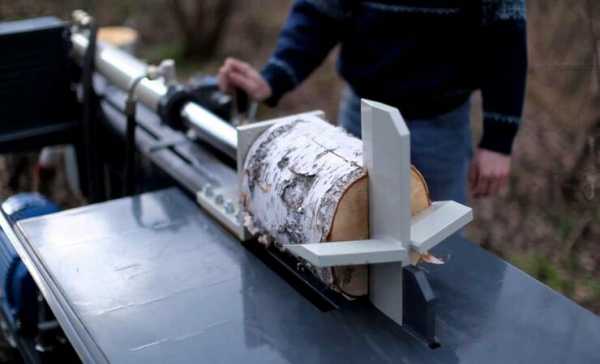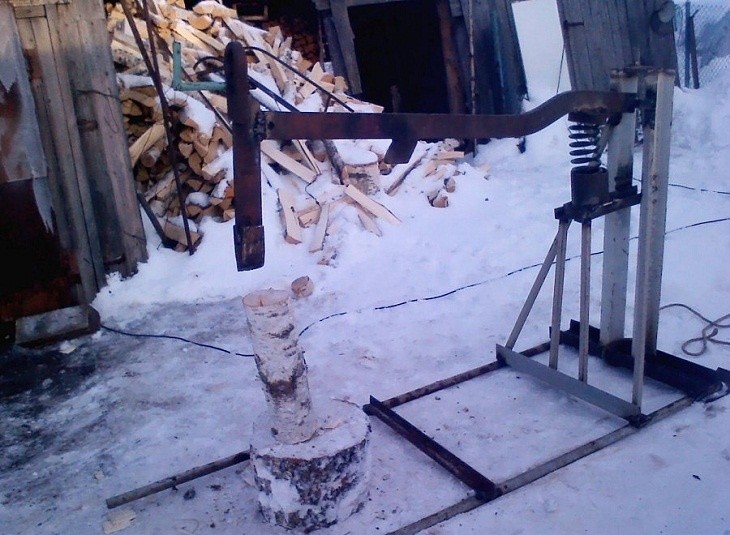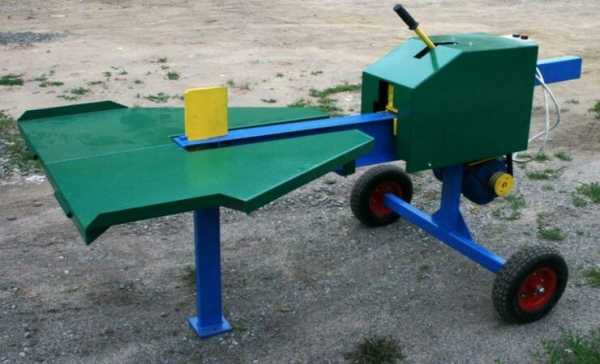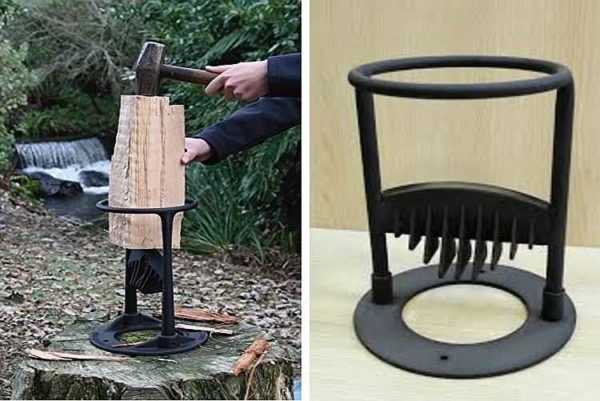Diy wood splitter photo
















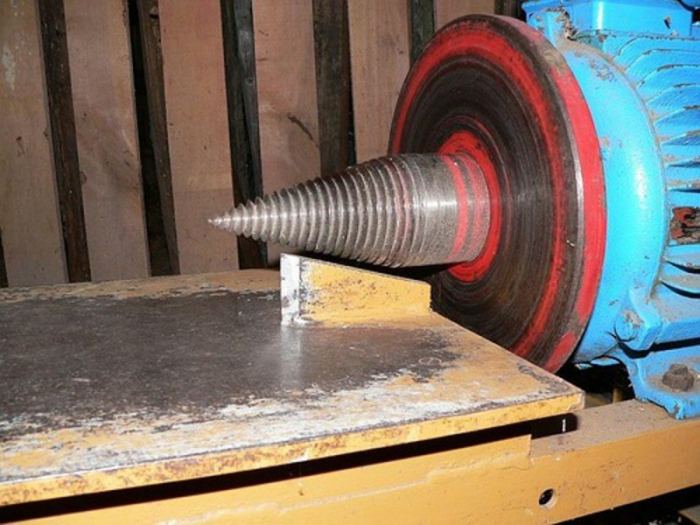






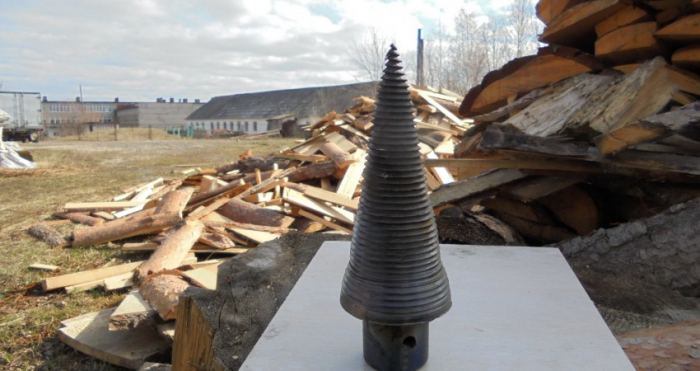








We also recommend viewing:
- How to make a cold smoked smokehouse
- DIY smokehouse construction
- How to make a hot smoked smokehouse with your own hands
- How to make curtains for a gazebo with your own hands
- Efficient collection of rainwater
- We do water supply in the country with our own hands
- Instructions on how to make furniture from pallets
- Do-it-yourself pool cleaning
- Watering options for the site
- Instructions on how to easily remove the stump
- How to make a garage door with your own hands
- How to make a snow blower with your own hands
- Wood preservatives
- Simple drinker for chickens
- How to clean up the soot
- Good dry closet for a summer residence
- How to make a brazier with your own hands
- Good heating for the greenhouse
- Modern winter greenhouse
- Roof drainage system
- How to make a chicken feeder
- DIY decking
- How to make molds for paving slabs
- Instructions on how to equip a garage
- How to make grounding in a private house
- Gate lock
Finally about hand axes
If you do not have the opportunity to make a mechanized wood splitter yourself, you will have to chop wood in the traditional way.
It is important to choose a convenient tool that will make your work as easy as possible.
How to choose axes for chopping wood:
- The shops sell cleavers with different handle lengths and blade weights (2-5 kg). Get the tool that suits your physical condition, because you need to swing the ax often and for a long time. You should not immediately take the heaviest copies.
- The wooden ax of quality products is cut from elm, maple or birch. These rocks do not crumble into chips and do not split.
- Do not buy an ax with a handle that is too short to reduce the force of impact. An overly long handle can be easily cut to size.
- Make sure that the "head" fits snugly on the handle.
If the budget allows, you should pay attention to the more practical imported cleavers with a sturdy plastic handle and various blade profiles made of high quality steel. Popular options are straight axes from Fiskars and wood choppers with an offset center of gravity from Vipukirves
Rack and pinion device
 At the heart of such a unit is a pusher fixed on a rail, moving due to a gear transmission. The mechanism is activated by pressing a special handle that engages the gears. The pusher moves the log onto the fixed knife and the latter divides the workpiece into parts. Pulling the handle back returns the pusher to its original position. Movement is provided by a motor that transmits torque to the gear using a V-belt drive.
At the heart of such a unit is a pusher fixed on a rail, moving due to a gear transmission. The mechanism is activated by pressing a special handle that engages the gears. The pusher moves the log onto the fixed knife and the latter divides the workpiece into parts. Pulling the handle back returns the pusher to its original position. Movement is provided by a motor that transmits torque to the gear using a V-belt drive.
Basically, it is necessary to adjust the course of the rail when assembling the wood splitter. Safety is ensured by a smooth increase in the power of the force in the belt drive. When overloaded, the belt slips, preventing engine damage.
The wood splitter consists of a motor drive, a belt drive pulley on the output shaft, a counter pulley, larger in diameter, on the secondary shaft rotating on bearings, a gear wheel on the secondary shaft, a spring-loaded rack, frame, knife, control knob.
 First, the bed is assembled. The frame for it is made of an I-beam, channel or profile pipe. The pusher mechanism, knife, motor and gearbox are installed. The gear should rise above the bed by 4-6 cm and be at a distance two logs from a knife. A hinge is installed on the carriage to raise and lower the rack, and a spring mount is made to lift the rack above the pinion.Mount the return spring and install the pressure rack handle to the gear. If necessary, cut the rail, its length should be less than the distance from the feed plate to the knife.
First, the bed is assembled. The frame for it is made of an I-beam, channel or profile pipe. The pusher mechanism, knife, motor and gearbox are installed. The gear should rise above the bed by 4-6 cm and be at a distance two logs from a knife. A hinge is installed on the carriage to raise and lower the rack, and a spring mount is made to lift the rack above the pinion.Mount the return spring and install the pressure rack handle to the gear. If necessary, cut the rail, its length should be less than the distance from the feed plate to the knife.
As you have seen, making a log splitter is not so difficult if you have working skills.
Just carefully study your chosen circuit, assemble the necessary components, adhere to safety rules during assembly and, finally, pay special attention to the electrical part of your device.
When firewood comes in handy
Butt parts of woodlands and, especially, stumps from uprooting, as is known, give a lot of heat when burned. You can buy them for firewood inexpensively, but in Russia in some places and simply for self-delivery: for cellulose, fiber for MDF and technical chips for OSB, chipboard and fiberboard, they are of little use. But it is not so easy to split such a whole gnarled block of wood inside and outside into firewood. However, for harvesting at home a small amount of additional wood fuel to the main fuel, this task, over which woodworking specialists are still struggling, is quite solvable.
How? It is necessary to make a cone log splitter: it does not forcefully split the chura, but forces it to crack as it is most convenient for him. If the workpiece is no more than 60 cm in diameter, then the resulting logs will fit into the furnace firebox. Their transverse dimensions are not optimal for the most economical combustion, but the fuel is also wasteful.

Cone log splitter device
The device of the cone wood splitter is shown in Fig. on right. The diameter of the base of the cone is 80-150 mm, depending on the largest size of the available blocks. Apex angle - 15 degrees for shallow wood and 18 degrees for straight wood. Approx. 1/3 of the height of the cone from the base, it is replaced by an opening angle of 22 and 25-30 degrees, respectively. It is better to use a rack and pinion jack. The fact is that the autojack is an emergency device that is not designed for frequent regular use. There is nowhere to simplify the rack jack further, but the hydraulic one in the wood splitter will flow pretty soon. For comparison: a stamping hydraulic press that develops the same force is a solid structure weighing more than a ton.
One more nuance: it is better to make the adjusting rod of the cone splitter to the worker. To do this, it is made from a bar of steel St45 or stronger with a diameter of 24 mm. The thread is cut trapezoidal (you can use parts from an unusable main gas or water valve). The steering wheel is replaced with a lever gate. Then, together with an assistant, it will be possible to split the fattest vilest of the vile churak. Frame - channels from 150 mm and pipes from 60x4.
How to chop wood correctly
Many summer residents chop wood by putting a log on the ground, but experienced woodcutters categorically do not recommend doing this, and here's why:
- This is dangerous because you can hit the leg with an ax and get seriously injured.
- This is inconvenient because the lumberjack has to bend low. It is especially difficult for obese people to bend over.
- This has a bad effect on the quality of firewood, since a log lying on the ground instantly damp.
 It is best to use a special metal structure for splitting, resembling a machine tool in shape. In the middle of the machine there is a chute into which the log is placed: here it is securely fixed and does not jump out. When the log, or "block", lies exactly in its place, the woodcutter takes the cleaver and lifts it up to strike and with a sharp movement lowers it onto the log. If struck correctly, the block splits into pieces. The main thing is to correctly calculate the force of the blow, then these parts will turn out to be even and neat, but this comes with experience.
It is best to use a special metal structure for splitting, resembling a machine tool in shape. In the middle of the machine there is a chute into which the log is placed: here it is securely fixed and does not jump out. When the log, or "block", lies exactly in its place, the woodcutter takes the cleaver and lifts it up to strike and with a sharp movement lowers it onto the log. If struck correctly, the block splits into pieces. The main thing is to correctly calculate the force of the blow, then these parts will turn out to be even and neat, but this comes with experience.
You should never raise the cleaver too high, because the force of the blow will not increase from this, but, on the contrary, will weaken. Also, do not swing an ax before making a blow: the lumberjack does not need to spend extra strength.
Design and principle of operation
Firewood will not lose its relevance for a long time, remaining a convenient, economical and environmentally friendly type of fuel. There are several reasons for this:
- in the outback in many houses to this day there is no alternative to stove heating;
- saunas, baths, offering their services to attract customers, almost always indicate that they use firewood to generate heat, moreover, environmentally friendly and of certain species;
- no picnic is complete without a good old fire - both for cooking and for creating a warm and cozy atmosphere.
Initially, various types of manual cleavers and wedges were used to facilitate the process of splitting firewood. But in the process of operation, such primitive devices proved to be ineffective, as they were traumatic, and often just got stuck in a log. Therefore, they were replaced by a wood splitter. This simple mechanism saves not only energy, but also a lot of time. But the craftsmen did not stop there either, deciding to completely minimize the effort and time spent on the process of harvesting firewood, improving the technology of woodcutters. This is how the mechanical type wood splitters appeared.


Depending on the type of construction, the wood splitter consists of the simplest support-shoulder to increase the applied force or a number of side mechanisms that serve to facilitate the process of harvesting firewood. Side mechanisms include the shoulder to which the cleaver is attached, and the frame - the frame on which the cleaver is held. In general, a complex of such simple devices forms a mechanism that can facilitate the work of harvesting firewood.

When you need a little firewood
In the southern regions and / or for heating the utility rooms, little firewood is required. A normal peasant could easily pin them by hand, and then let the faithful just try not to serve the stopper for dinner. But - the problem: the correct swing. Without it, swinging a cleaver is exhausting and dangerous, and working out a swing for chopping wood is no easier than using a cold weapon; see, for example, how a fighter chops wood in Kurosawa's Seven Samurai.
A manual mechanical wood splitter, again contrary to popular belief, saves little or no muscle effort when chopping wood, but allows it to be safely produced without having to wield the lumberjack's swing. Its additional advantage is that it can operate in both gravitational-inertial and push mode. The latter allows you to slowly, little by little, but to manage with the most stubborn blocks of almost any diameter. The main thing is that their cuts are parallel and approximately perpendicular to the longitudinal axis of the block, otherwise it will be much more dangerous to work.
Sliding cleaver log splitter device
The device of a manual mechanical wood splitter is shown in Fig. The lever arm is taken from 1.5 m; the bigger, the better. Surcharge - depending on its strength, 10-50 kg. If the cleaver is fixed motionless, this wood splitter works only as an inertial one: the lever is lifted by the handle and forcefully lowered onto the churak. If the cleaver can be moved along the lever, then the wood splitter can also be push; the arm of the lever is lengthened by a pipe put on the handle.
There are a number of significant nuances in the design of a lever-type manual wood splitter (shown by the arrows on the right in the figure). The first is a cleaver. A simple rail trim wedge is ineffective and sticks in wood. Such a wood splitter works much better with the arrow cleaver (see above), especially since you can buy it inexpensively ready-made. The second is the spring, it is the most traumatic element in this design. The force of the spring is needed so that the free lever with the cleaver in the extreme far position is held approximately horizontally. It is necessary to fasten the spring on the heels so that it does not come off them with a full swing of the lever; it is better to pass the swinging guide into the spring.

Manual mechanical wood splitter device
And the last thing - if the lever log splitter is not rigidly attached to the support area, then its front legs must be made at least as long as the maximum lever arm + double diameter of the largest block. How to make a lever log splitter with improved kinematics yourself, see next. video:

